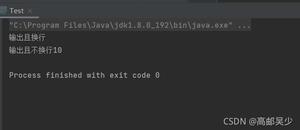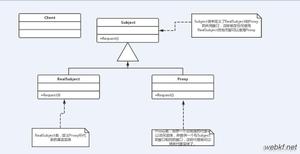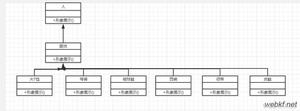java web 学习十六(JSP指令)

一、JSP指令简介
JSP指令(directive)是为JSP引擎而设计的,它们并不直接产生任何可见输出,而只是告诉引擎如何处理JSP页面中的其余部分。
在JSP 2.0规范中共定义了三个指令:
- page指令
- Include指令
- taglib指令
JSP指令的基本语法格式:<%@ 指令 属性名="值" %>
例如:
1 <%@ page contentType="text/html;charset=gb2312"%>
如果一个指令有多个属性,这多个属性可以写在一个指令中,也可以分开写。
例如:
1 <%@ page contentType="text/html;charset=gb2312"%>2 <%@ page import="java.util.Date"%>
也可以写作:
1 <%@ page contentType="text/html;charset=gb2312" import="java.util.Date"%>
二、Page指令
page指令用于定义JSP页面的各种属性,无论page指令出现在JSP页面中的什么地方,它作用的都是整个JSP页面,为了保持程序的可读性和遵循良好的编程习惯,page指令最好是放在整个JSP页面的起始位置。例如:
JSP 2.0规范中定义的page指令的完整语法:
<%@ page[ language="java" ]
[ extends="package.class" ]
[ import="{package.class | package.*}, ..." ]
[ session="true | false" ]
[ buffer="none | 8kb | sizekb" ]
[ autoFlush="true | false" ]
[ isThreadSafe="true | false" ]
[ info="text" ]
[ errorPage="relative_url" ]
[ isErrorPage="true | false" ]
[ contentType="mimeType [ ;charset=characterSet ]" | "text/html ; charset=ISO-8859-1" ]
[ pageEncoding="characterSet | ISO-8859-1" ]
[ isELIgnored="true | false" ]
%>
2.1、page指令的import属性
在Jsp页面中,Jsp引擎会自动导入下面的包
- java.lang.*
- javax.servlet.*
- javax.servlet.jsp.*
- javax.servlet.http.*
可以在一条page指令的import属性中引入多个类或包,其中的每个包或类之间使用逗号(,)分隔
例如:
1 <%@ page import="java.util.*,java.io.*,java.sql.*"%>
上面的语句也可以改写为使用多条page指令的import属性来分别引入各个包或类
例如:
1 <%@ page import="java.util.Date"%>2 <%@ page import="java.io.*" %>
3 <%@ page import="java.sql.*" %>
2.2、page指令的errorPage属性
- errorPage属性的设置值必须使用相对路径,如果以“/”开头,表示相对于当前Web应用程序的根目录(注意不是站点根目录),否则,表示相对于当前页面
- 可以在web.xml文件中使用<error-page>元素为整个Web应用程序设置错误处理页面。
- <error-page>元素有3个子元素,<error-code>、<exception-type>、<location>
- <error-code>子元素指定错误的状态码,例如:<error-code>404</error-code>
- <exception-type>子元素指定异常类的完全限定名,例如:<exception-type>java.lang.ArithmeticException</exception-type>
- <location>子元素指定以“/”开头的错误处理页面的路径,例如:<location>/ErrorPage/404Error.jsp</location>
- 如果设置了某个JSP页面的errorPage属性,那么在web.xml文件中设置的错误处理将不对该页面起作用。
2.3、使用errorPage属性指明出错后跳转的错误页面
比如Test.jsp页面有如下的代码:
<%@ page language="java" import="java.util.*" errorPage="/ErrorPage/error.jsp" pageEncoding="UTF-8"%><html>
<head>
<title>测试page指令的errorPage属性</title>
</head>
<body>
<%
//这行代码肯定会出错,因为除数是0,一运行就会抛出异常
int x = 1/0;
%>
</body>
</html>
在Test.jsp中,page指令的errorPage属性指明了出错后跳转到"/ErrorPage/error.jsp",error.jsp页面代码如下:
<%@ page language="java" import="java.util.*" pageEncoding="UTF-8"%><html>
<head>
<title>错误信息友好提示页面</title>
</head>
<body>
对不起,出错了,请联系管理员解决!
</body>
</html>
运行结果如下:
2.4、在web.xml中使用<error-page>标签为整个web应用设置错误处理页面
例如:使用<error-page>标签配置针对404错误的处理页面
web.xml的代码下:
<?xml version="1.0" encoding="UTF-8"?><web-app version="3.0"
xmlns="http://java.sun.com/xml/ns/javaee"
xmlns:xsi="http://www.w3.org/2001/XMLSchema-instance"
xsi:schemaLocation="http://java.sun.com/xml/ns/javaee
http://java.sun.com/xml/ns/javaee/web-app_3_0.xsd">
<display-name></display-name>
<welcome-file-list>
<welcome-file>index.jsp</welcome-file>
</welcome-file-list>
<!-- 针对404错误的处理页面 -->
<error-page>
<error-code>404</error-code>
<location>/ErrorPage/404Error.jsp</location>
</error-page>
</web-app>
404Error.jsp代码如下:
<%@ page language="java" import="java.util.*" pageEncoding="UTF-8"%><html>
<head>
<title>404错误友好提示页面</title>
<!-- 3秒钟后自动跳转回首页 -->
<meta http-equiv="refresh" content="3;url=${pageContext.request.contextPath}/index.jsp">
</head>
<body>
<img alt="对不起,你要访问的页面没有找到,请联系管理员处理!"
src="${pageContext.request.contextPath}/img/404Error.png"/><br/>
3秒钟后自动跳转回首页,如果没有跳转,请点击<a href="${pageContext.request.contextPath}/index.jsp">这里</a>
</body>
</html>
当访问一个不存在的web资源时,就会跳转到在web.xml中配置的404错误处理页面404Error.jsp,如下图所示:
2.5、关于在web.xml中使用<error-page>标签为整个web应用设置错误处理页面在IE下无法跳转的解决办法
这里需要注意的是,如果错误页面比较小,那么当访问服务器上不存在的web资源或者访问服务器出错时在IE浏览器下是无法跳转到错误页面的,显示的是ie自己的错误页面,而在火狐和google浏览器下(其他浏览器没有测试过)是不存在注意的问题的。
我们可以通过下面的实验来证明
在web.xml中配置500错误时的错误友好提示页面
1 <!-- 针对500错误的处理页面 -->2 <error-page>
3 <error-code>500</error-code>
4 <location>/ErrorPage/500Error.jsp</location>
5 </error-page>
500Error.jsp页面的代码如下:
<%@ page language="java" import="java.util.*" pageEncoding="UTF-8"%><html>
<head>
<title>500(服务器错误)错误友好提示页面</title>
<!-- 3秒钟后自动跳转回首页 -->
<meta http-equiv="refresh" content="3;url=${pageContext.request.contextPath}/index.jsp">
</head>
<body>
<img alt="对不起,服务器出错!"
src="${pageContext.request.contextPath}/img/500Error.png"/><br/>
3秒钟后自动跳转回首页,如果没有跳转,请点击<a href="${pageContext.request.contextPath}/index.jsp">这里</a>
</body>
</html>
500Error.jsp页面的字节大小
在IE8浏览器下的运行结果:
在IE下访问Test.jsp出现500错误后,显示的是ie自己的错误页面,而不是我们定制的那个500错误页面,而在google和火狐下却是可以正常跳转到我们自己定制的那个500错误页面的,如下图所示:
很多人遇到这个问题,而解决这个问题的办法有两种:
1、修改IE浏览器的设置(不推荐)
操作步骤:在IE【工具】->【Internet选项】->【高级】中勾掉【显示友好http错误提示】
经过这样的设置之后,访问服务器出错后就可以直接跳转到我们定制的500错误页面了,如下图所示:
这种做法需要修改客户端浏览器的配置,不推荐这样的方式。
2.不修改IE浏览器的设置下确保定制的错误页面的大小>1024字节
修改500Error.jsp,多添加一些内容,让页面的字节数大一些,修改后的500Error.jsp的代码如下:
<%@ page language="java" import="java.util.*" pageEncoding="UTF-8"%><html>
<head>
<title>500(服务器错误)错误友好提示页面</title>
<!-- 3秒钟后自动跳转回首页 -->
<meta http-equiv="refresh" content="3;url=${pageContext.request.contextPath}/index.jsp">
</head>
<body>
<img alt="对不起,服务器出错了,请联系管理员解决!"
src="${pageContext.request.contextPath}/img/500Error.png"/><br/>
3秒钟后自动跳转回首页,如果没有跳转,请点击<a href="${pageContext.request.contextPath}/index.jsp">这里</a>
</body>
</html>
也就多加了几个中文,让500Error.jsp多了几个字节,500Error.jsp现在的字节数如下:
在IE下访问,当服务器出错时,就可以正常跳转到500Error.jsp这个定制的错误页面了,如下图所示:
经过测试,当定制的错误页面的size=617bytes时,在IE8下已经可以跳转到定制的错误页面了,其他版本的IE浏览器没有经过测试,不过为了保险起见,定制的错误页面的size最好超过1024bytes。
2.6、使用page指令的的isErrorPage属性显式声明页面为错误页面
如果某一个jsp页面是作为系统的错误处理页面,那么建议将page指令的isErrorPage属性(默认为false)设置为"true"来显式声明这个Jsp页面是一个错误处理页面。
例如:将error.jsp页面显式声明为错误处理页面
<%@ page language="java" import="java.util.*" pageEncoding="UTF-8" isErrorPage="true"%><html>
<head>
<title>错误信息友好提示页面</title>
</head>
<body>
对不起,出错了,请联系管理员解决!
</body>
</html>
将error.jsp页面显式声明为错误处理页面后,有什么好处呢,好处就是Jsp引擎在将jsp页面翻译成Servlet的时候,在Servlet的 _jspService方法中会声明一个exception对象,然后将运行jsp出错的异常信息存储到exception对象中,如下所示:
由于Servlet的_jspService方法中声明了exception对象,那么就可以在error.jsp页面中使用exception对象,这样就可以在Jsp页面中拿到出错的异常信息了,如下:
如果没有设置isErrorPage="true",那么在jsp页面中是无法使用exception对象的,因为在Servlet的_jspService方法中不会声明一个exception对象,如下所示:
Jsp有9大内置对象,而一般情况下exception对象在Jsp页面中是获取不到的,只有设置page指令的isErrorPage属性为"true"来显式声明Jsp页面是一个错误处理页面之后才能够在Jsp页面中使用exception对象。
三、include指令
在JSP中对于包含有两种语句形式:
- @include指令
- <jsp:include>指令
3.1、@include指令
@include可以包含任意的文件,当然,只是把文件的内容包含进来。
include指令用于引入其它JSP页面,如果使用include指令引入了其它JSP页面,那么JSP引擎将把这两个JSP翻译成一个servlet。所以include指令引入通常也称之为静态引入。
语法:<%@ include file="relativeURL"%>,其中的file属性用于指定被引入文件的路径。路径以“/”开头,表示代表当前web应用。
include指令细节注意问题:
- 被引入的文件必须遵循JSP语法。
- 被引入的文件可以使用任意的扩展名,即使其扩展名是html,JSP引擎也会按照处理jsp页面的方式处理它里面的内容,为了见明知意,JSP规范建议使用.jspf(JSP fragments(片段))作为静态引入文件的扩展名。
- 由于使用include指令将会涉及到2个JSP页面,并会把2个JSP翻译成一个servlet,所以这2个JSP页面的指令不能冲突(除了pageEncoding和导包除外)。
include指令使用范例:
新建head.jspf页面和foot.jspf页面,分别作为jsp页面的头部和尾部,存放于WebRoot下的jspfragments文件夹中,代码如下:
head.jspf代码:
1 <%@ page language="java" import="java.util.*" pageEncoding="UTF-8"%>2 <h1 style="color:red;">网页头部</h1>
foot.jspf代码:
1 <%@ page language="java" import="java.util.*" pageEncoding="UTF-8"%>2 <h1 style="color:blue;">网页尾部</h1>
在WebRoot文件夹下创建一个IncludeTagTest.jsp页面,在IncludeTagTest.jsp页面中使用@include指令引入head.jspf页面和foot.jspf页面,代码如下:
<%@ page language="java" import="java.util.*" pageEncoding="UTF-8"%><!DOCTYPE HTML PUBLIC "-//W3C//DTD HTML 4.01 Transitional//EN">
<html>
<head>
<title>jsp的Include指令测试</title>
</head>
<body>
<%--使用include标签引入引入其它JSP页面--%>
<%@include file="/jspfragments/head.jspf" %>
<h1>网页主体内容</h1>
<%@include file="/jspfragments/foot.jspf" %>
</body>
</html>
运行结果如下:
我们查看一下jsp引擎将IncludeTagTest.jsp翻译成IncludeTagTest_jsp类之后的源代码,找到Tomcat服务器的work\Catalina\localhost\JavaWeb_Jsp_Study_20140603\org\apache\jsp目录下找到IncludeTagTest_jsp.java,如下图所示:
打开IncludeTagTest_jsp.java,里面的代码如下所示:
package org.apache.jsp;import javax.servlet.*;
import javax.servlet.http.*;
import javax.servlet.jsp.*;
import java.util.*;
import java.util.*;
import java.util.*;
public final class IncludeTagTest_jsp extends org.apache.jasper.runtime.HttpJspBase
implements org.apache.jasper.runtime.JspSourceDependent {
private static final JspFactory _jspxFactory = JspFactory.getDefaultFactory();
private static java.util.List _jspx_dependants;
static {
_jspx_dependants = new java.util.ArrayList(2);
_jspx_dependants.add("/jspfragments/head.jspf");
_jspx_dependants.add("/jspfragments/foot.jspf");
}
private javax.el.ExpressionFactory _el_expressionfactory;
private org.apache.AnnotationProcessor _jsp_annotationprocessor;
public Object getDependants() {
return _jspx_dependants;
}
public void _jspInit() {
_el_expressionfactory = _jspxFactory.getJspApplicationContext(getServletConfig().getServletContext()).getExpressionFactory();
_jsp_annotationprocessor = (org.apache.AnnotationProcessor) getServletConfig().getServletContext().getAttribute(org.apache.AnnotationProcessor.class.getName());
}
public void _jspDestroy() {
}
public void _jspService(HttpServletRequest request, HttpServletResponse response)
throws java.io.IOException, ServletException {
PageContext pageContext = null;
HttpSession session = null;
ServletContext application = null;
ServletConfig config = null;
JspWriter out = null;
Object page = this;
JspWriter _jspx_out = null;
PageContext _jspx_page_context = null;
try {
response.setContentType("text/html;charset=UTF-8");
pageContext = _jspxFactory.getPageContext(this, request, response,
null, true, 8192, true);
_jspx_page_context = pageContext;
application = pageContext.getServletContext();
config = pageContext.getServletConfig();
session = pageContext.getSession();
out = pageContext.getOut();
_jspx_out = out;
out.write("\r\n");
out.write("<!DOCTYPE HTML PUBLIC \"-//W3C//DTD HTML 4.01 Transitional//EN\">\r\n");
out.write("<html>\r\n");
out.write(" <head>\r\n");
out.write(" \r\n");
out.write(" <title>jsp的Include指令测试</title>\r\n");
out.write(" \r\n");
out.write(" </head>\r\n");
out.write(" \r\n");
out.write(" <body>\r\n");
out.write(" ");
out.write("\r\n");
out.write("<h1 style=\"color:red;\">网页头部</h1>\r\n");
out.write("\r\n");
out.write(" <h1>网页主体内容</h1>\r\n");
out.write(" ");
out.write("\r\n");
out.write("<h1 style=\"color:blue;\">网页尾部</h1>\r\n");
out.write("\r\n");
out.write(" </body>\r\n");
out.write("</html>\r\n");
} catch (Throwable t) {
if (!(t instanceof SkipPageException)){
out = _jspx_out;
if (out != null && out.getBufferSize() != 0)
try { out.clearBuffer(); } catch (java.io.IOException e) {}
if (_jspx_page_context != null) _jspx_page_context.handlePageException(t);
}
} finally {
_jspxFactory.releasePageContext(_jspx_page_context);
}
}
}
可以看到,head.jspf和foot.jspf页面的内容都使用out.write输出到浏览器显示了。
3.2、总结@include指令
使用@include可以包含任意的内容,文件的后缀是什么都无所谓。这种把别的文件内容包含到自身页面的@include语句就叫作静态包含,作用只是把别的页面内容包含进来,属于静态包含。
3.3、jsp:include指令
jsp:include指令为动态包含,如果被包含的页面是JSP,则先处理之后再将结果包含,而如果包含的是非*.jsp文件,则只是把文件内容静态包含进来,功能与@include类似。后面再具体介绍
转载:http://www.cnblogs.com/xdp-gacl/p/3778993.html
以上是 java web 学习十六(JSP指令) 的全部内容, 来源链接: utcz.com/z/390324.html









